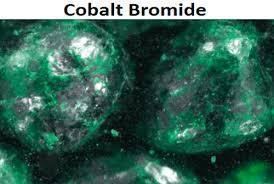Molar mass 218.74 g/mol Boiling point 927 °C | Melting point 678 °C Density 4.91 g/cm³ | |
 | ||
Formula CoBr2,CoBr2·6H2O,CoBr2·2H2O Appearance Bright green crystals (anhydrous); Red-purple crystals (hexahydrate) | ||
Cobalt(II) bromide (CoBr2) is an inorganic compound. It is a red solid that is soluble in water, used primarily as a catalyst in some processes.
Contents
Properties
When anhydrous, cobalt(II) bromide appears as green crystals. The hexahydrate loses four waters of crystallization molecules at 100 °C forming the dihydrate:
CoBr2.6H2O → CoBr2.2H2O + 4 H2OFurther heating to 130 °C produces the anhydrous form:
CoBr2.2H2O → CoBr2 + 2 H2OThe anhydrous form melts at 678 °C. At higher temperatures, cobalt(II) bromide reacts with oxygen, forming cobalt(II,III) oxide and bromine vapor.
Preparation
Cobalt(II) bromide can be prepared as a hydrate by the reaction of cobalt hydroxide with hydrobromic acid:
Co(OH)2(s) + 2HBr(aq) → CoBr2.6H2O(aq)Anhydrous cobalt(II) bromide may be prepared through the direct reaction of elemental cobalt and liquid bromine.
Reactions and uses
The classical coordination compound bromopentaamminecobalt(III) bromide is prepared by oxidation of a solution of cobalt(II) bromide in aqueous ammonia.
2 CoBr2 + 8 NH3 + 2 NH4Br + H2O2 → 2 [Co(NH3)5Br]Br2 + 2 H2OTriphenylphosphine complexes of cobalt(II) bromide have been used as a catalysts in organic synthesis.
Safety
Exposure to large amounts of cobalt(II) can cause cobalt poisoning. Bromide is also mildly toxic.
